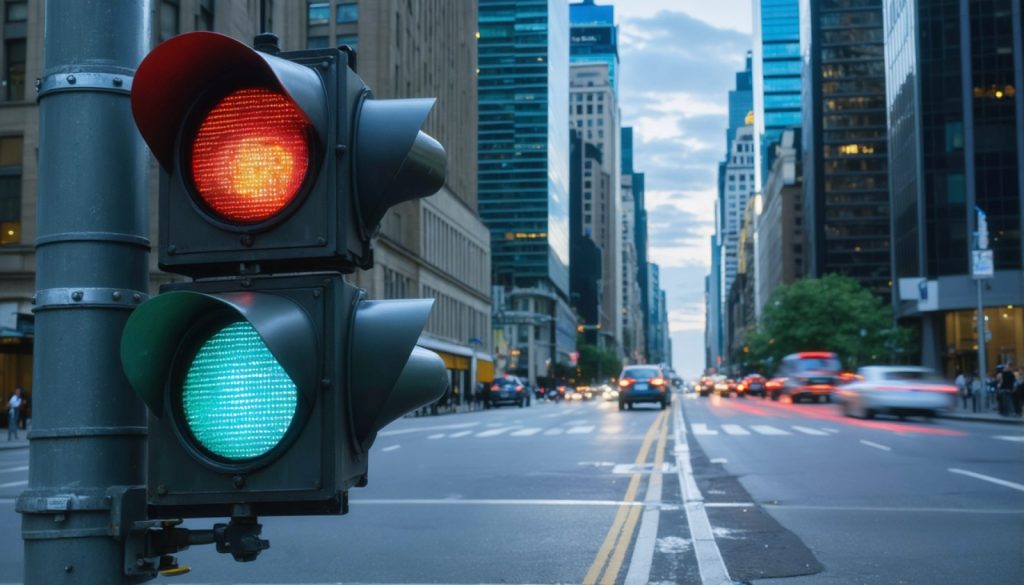
- Smart traffic lights, powered by advanced algorithms, are revolutionizing urban mobility by reducing gridlock and emissions.
- Real-time data from sensors and cameras allow traffic signals to adapt, cutting wait times by up to 20% during rush hours.
- The reduction in idle times and smooth traffic flow significantly decrease carbon emissions, equivalent to removing cars from the road.
- Smart systems prioritize pedestrian and cyclist safety with adaptive crossing signals and extended green cycles.
- Cities globally, like Amsterdam and Singapore, are investing in this technology, enhancing urban living through sustainable solutions.
- Embodying the smart city ideal, smart traffic lights demonstrate the potential of technology to improve urban efficiency and quality of life.
Amidst the pulsating heart of modern cities lies a transformative technology quietly reshaping how we live and move—smart traffic lights. These digital sentinels are bringing order to the chaos of urban streets, using advanced algorithms and real-time data to minimize gridlock, reduce emissions, and enhance pedestrian safety.
Picture this: It’s 8 a.m. on a Monday, the typical rush hour frenzy. Yet, unlike the snarled mess of yesteryear, today’s intersections smoothly guide their automotive ballet. The secret? Intelligent traffic signals, equipped with sensors and cameras, seamlessly adjust their operation to harmonize with the ebb and flow of morning commuters.
Real-time responsiveness forms the backbone of this technology. Leveraging data from ground sensors and surveillance systems, these lights not only respond to vehicle numbers but also anticipate traffic surges. This proactive approach slashes wait times by up to 20%, allowing workers and students alike to reach their destinations with minimal delay.
Environmental benefits further amplify the allure of smart traffic systems. By reducing idle times and unnecessary acceleration, cities can significantly cut carbon emissions. The reduction in fuel consumption is equivalent to removing thousands of cars from the road, making urban centers cleaner and more breathable.
Beyond vehicular efficiency, smart lights are champions of pedestrian and cyclist safety. They offer adaptive crossing signals that prioritize foot traffic during high-density periods, ensuring that every jaywalker finds their runway. Cyclists, too, benefit from extended green cycles, fostering a safer, more bike-friendly environment.
Embracing the future, cities around the world are actively investing in this technology. From Amsterdam’s bike-prioritizing signals to Singapore’s AI-driven traffic analysts, each deployment represents a step towards smarter, more sustainable urban living.
This blend of innovation and practicality forms a cornerstone of the smart city ideal—an urban landscape where technology serves its residents, enhancing daily life with precision and ease. The takeaway? Smart traffic lights exemplify how thoughtful tech integration can unlock the secrets of urban efficiency, painting a vivid picture of what cities of the future can offer—a world where technology doesn’t just move us forward, but helps us breathe, coexist, and thrive.
Discover How Smart Traffic Lights Are Revolutionizing City Life
The Future of Urban Traffic Management: A Comprehensive Guide
Smart traffic lights are quickly becoming a cornerstone of modern urban infrastructure. By integrating cutting-edge technology, these systems are creating more sustainable and efficient cities. In this expanded look at smart traffic lights, we’ll delve into lesser-known facets, the potential they hold, and provide actionable insights you can use.
How Smart Traffic Lights Work
Smart traffic lights use a range of technologies, such as:
– Sensors and Cameras: Embedded in roads to detect the number and speed of vehicles, enabling lights to adjust in near real-time.
– Machine Learning Algorithms: Capable of predicting traffic patterns and adjusting light cycles to accommodate variations in traffic flow.
– IoT Connectivity: Allows traffic systems to communicate with city-wide infrastructure and vehicles (via connected car systems).
Real-World Use Cases
1. Improved Emergency Response: In cities like Los Angeles, smart traffic lights are used to create ‘green corridors’ to help emergency vehicles reach their destination faster, thus saving lives.
2. Public Transport Integration: Cities like Melbourne are integrating smart lights with public transit systems to prioritize buses and trams, reducing delays.
3. Environmental Impact: According to a study from the Journal of Transportation Research, optimizing traffic lights can reduce fuel consumption by up to 15%, directly lowering CO2 emissions.
Market Forecast & Industry Trends
The global market for smart traffic management systems is projected to exceed USD 7 billion by 2025, driven by increasing urbanization and the need for efficient city planning. Key players include Siemens, Swarco, and Econolite.
Reviews & Comparisons
Smart traffic lights have shown impressive results, but their effectiveness can vary based on geographic and infrastructural factors. For instance, while they demonstrate significant improvements in urban centers, their impact might be less pronounced in rural areas with lower traffic density.
Controversies & Limitations
– Privacy Concerns: The extensive use of cameras and sensors raises questions about data privacy, making robust data protection policies a necessity.
– High Initial Costs: While long-term savings are substantial, the upfront investment required can be a barrier for some municipalities.
Features, Specs & Pricing
Typical smart traffic light systems include:
– Real-time Data Processing Capabilities
– Modular Sensor Design adaptable to different environments
– Robust Connectivity Options, including 5G and IoT
Pricing varies significantly depending on the size and complexity of the installation, ranging from tens of thousands to millions of dollars per intersection.
Security & Sustainability
Security is paramount; thus, systems are fortified against cyberattacks that could alter traffic patterns with malicious intent. In terms of sustainability, smart traffic lights contribute to urban goals by reducing emissions and conserving energy.
Actionable Recommendations
1. Advocate for Policy Regulations: Support local governments in forming policies that secure data privacy.
2. Engage with Urban Planning Initiatives: Participate in discussions about implementing smart technology in your community.
3. Support Green Initiatives: Promote the adoption of smart traffic solutions as part of broader environmental sustainability practices.
For more information, visit Siemens and Swarco.
Start your journey towards a smarter, more sustainable future today by supporting and engaging with these emergent technologies. As cities evolve, so too can our approaches to making urban living more efficient and environmentally conscious.



